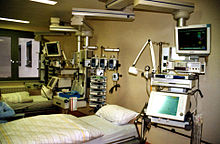Intensive care unit

An intensive care unit (ICU), critical care unit (CCU), intensive therapy unit or intensive treatment unit (ITU) is a specialized department used in many countries' hospitals that provides intensive care medicine. Many hospitals also have designated intensive care areas for certain specialities of medicine, as dictated by the needs and available resources of each hospital. The naming is not rigidly standardized.
History
In 1854, Florence Nightingale left for the Crimean War, where the necessity to separate seriously wounded soldiers from less-seriously wounded was observed. Nightingale reduced mortality from 40% to 2% on the battlefield, creating the concept of intensive care.
In 1950, anesthesiologist Peter Safar established the concept of "Advanced Support of Life," keeping patients sedated and ventilated in an intensive care environment. Safar is considered the first intensivist.
In response to a polio epidemic (where many patients required constant ventilation and surveillance), Bjørn Ibsen established the first intensive care unit in Copenhagen in 1953.[1] The first application of this idea in the United States was pioneered by Dr. William Mosenthal, a surgeon at the Dartmouth-Hitchcock Medical Center.[2] In the 1960s, the importance of cardiac arrhythmias as a source of morbidity and mortality in myocardial infarctions (heart attacks) was recognized. This led to the routine use of cardiac monitoring in ICUs, especially in the post-MI setting.
Types
Specialized types of ICUs include:
|
|
Equipment and systems
Common equipment in an ICU includes mechanical ventilator to assist breathing through an endotracheal tube or a tracheotomy opening; cardiac monitors including telemetry, external pacemakers, and defibrillators; dialysis equipment for renal problems; equipment for the constant monitoring of bodily functions; a web of intravenous lines, feeding tubes, nasogastric tubes, suction pumps, drains and catheters; and a wide array of drugs to treat the main condition(s). Medically induced comas, analgesics, and induced sedation reduce pain and prevent secondary infections.
Quality of care
Medicine suggests a relation between ICU volume and quality of care for mechanically ventilated patients.[3] After adjustment for severity of illness, demographic variables, and characteristics of the ICUs (including staffing by intensivists), higher ICU volume was significantly associated with lower ICU and hospital mortality rates. Typically, patient to nurse ratio is what determines the care. A ratio of 2 patients to 1 nurse is recommended for a medical ICU. This is unlike the ratio of 4:1 or 5:1 ratio on the medical floors.
Staff
Medical staff typically includes intensivists with training in internal medicine, surgery, anesthesia, or emergency medicine. Many nurse practitioners and physician assistants with specialized training are also now part of the staff that provide continuity of care for patients. Staff typically includes specially trained critical care registered nurses, registered respiratory therapists, clinical pharmacists, nutritionists, physical therapists, certified nursing assistants, social workers etc.
Intensive care around the world
In the United Kingdom intensive care medicine is an extremely specialised area. In the United States up to 20% of hospital beds can be labelled as intensive care beds, whereas in the United Kingdom intensive care usually will comprise only up to 2% of total beds. This high disparity is attributed to patients in the UK who are admitted to an ICU tending to be only the most severely ill.[4]
Intensive Care is an incredibly expensive healthcare service. In the United Kingdom the average cost of funding an intensive care unit is[5]:
- £838 per bed per day for a Neonatal Intensive Care Unit
- £1,702 per bed per day for a Paediatric Intensive Care Unit
- £1,328 per bed per day for an Adult Intensive Care Unit
See also
References
- ^ "Intensive Care Unit". Internet Journal of Health. Retrieved 2007-08-25.
- ^ "Remembering Dr. William Mosenthal: A simple idea from a special surgeon". Dartmouth Medicine. Retrieved 2007-04-10.
- ^ Kahn JM, Goss CH, Heagerty PJ, Kramer AA, O'Brien CR, Rubenfeld GD. (2006). "Hospital volume and the outcomes of mechanical ventilation". New England Journal of Medicine. 355 (1): 41–50. doi:10.1056/NEJMsa053993. Retrieved 2006-08-02.
{{cite journal}}: CS1 maint: multiple names: authors list (link) - ^ "ABC of Intensive Care". PubMed Central. Retrieved 2009-01-17.
- ^ "Written Answers for 15th June 2005 Page 38". House of Commons. Retrieved 2009-01-17.
